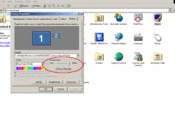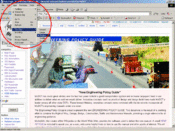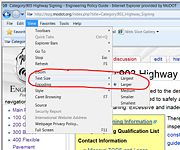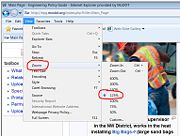Help Article: Difference between revisions
| Line 191: | Line 191: | ||
::'''''Planning:''''' Machelle Watkins | ::'''''Planning:''''' Machelle Watkins | ||
::'''''Traffic:''''' | ::'''''Traffic:''''' Jon Nelson | ||
:::Signs: Tom Honich | |||
:::Work Zones: Dan Smith | |||
Revision as of 13:55, 3 May 2019
| Engineering Policy Revision Request Form |
| Form to Propose Level 1, 2 and 3 Revisions for the EPG and other MoDOT Standards |
The Engineering Policy Guide (EPG) contains MoDOT policy, procedure and guidance for the planning, design, construction and maintenance of roadway and related facilities. It also includes specific technical topics of right of way, bridge, traffic and materials. The information is presented in numerous articles having as simple a layout as possible. These articles are numbered to reflect as closely as possible the pay items and divisions from the spec book, Missouri Standard Specifications for Highway Construction.
The EPG is not a contract document and EPG articles are referenced as EPG XXX.X or "articles" - not "sections" - to avoid confusion with MoDOT specs. Where a conflict exists between the EPG and a contract, the contract document rules. References and links to the Missouri Standard Specifications are given as "Sec XXX.XX" or "Section XXX.XX of the Standard Specifications." References and links to the Missouri Standard Plans for Highway Construction are "Standard Plan XXX.XX".
| EPG articles are not referenced as "sections" but as EPG XXX.X or "articles" to avoid confusion with MoDOT specs. |
Organization
Articles are grouped into the spec book’s divisions (for example, the EPG articles in EPG 100 General mirror Division 100 specs, articles in EPG 300 Bases mirror Division 300 specs, etc.). Many articles have been subdivided into additional articles. For example, the reader may notice that EPG 903.6 Warning Signs and other EPG 903 articles are listed at the bottom of EPG 903 Highway Signing.
In most articles the reader will notice numerous words in blue. These words are links to another article, figure or website with related information. This allows the reader to effectively navigate.
While every effort has been made to base the article numbers on MoDOT pay items and specs, not all articles in the EPG are reflected in the pay items and specs. For example, many EPG “100 General” articles are important to the design and construction of roadway facilities but do not directly correspond to specific pay items. Some of these are:
Similar examples are to be found in the EPG 200, EPG 300, etc. articles.
How best to view the articles
The articles are best viewed on your computer monitor with the following settings:
How to Easily Select and Print an Entire Article or a Portion of an Article
- 1) Highlight the selected article or portion of article
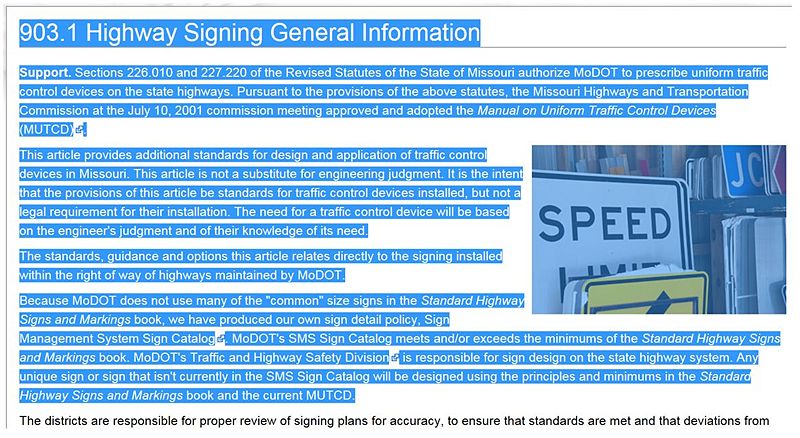
- 2) Click “File”
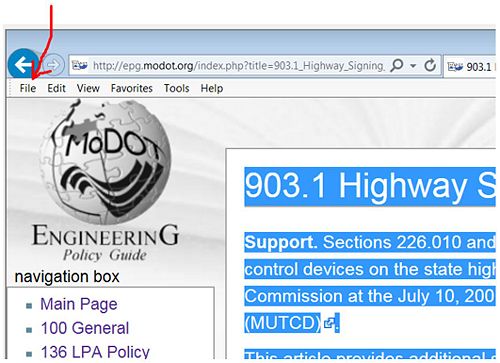
- 3) Click “Print Preview”
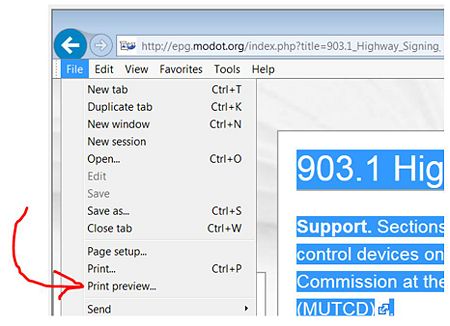
- 4) Select “As selected on screen”

- 5) Should your selection include a large table or figure that creates an undesirable appearance, you may want to click the “Shrink To Fit” tab and perhaps select “85%”.
- 6) Print the selection.
Use of Terms in the EPG
- Shall and Will indicate a required, mandatory, or specifically prohibitive practice. Shall and will statements shall not be modified or compromised based on engineering judgment or engineering study.
- Should indicates a recommended, but not mandatory, practice in typical situations. Deviations are allowed if engineering judgment or engineering study indicates the deviation to be appropriate.
- May indicates a permitted practice and carries no requirement or recommendation.
EPG Approval Process
| Proposed revisions are submitted on the Engineering Policy Revision Request Form. Just copy and paste the affected portion of your division's EPG article into a Word file. Place the Word file into revision mode and make your proposed changes to the file. (If your division’s info is already in the EPG, do not email Word files of revisions to your division’s old manual. Base your division's proposed revisions on EPG text, not the old manuals.) Attach this proposal to the form with the "Click here to attach a file" button. Along with the actual proposed textual revision of the EPG, provide: |
| 1) Any other standard affected by the revision, |
| 2) The name of the proposal's sponsor, |
| 3) The proposal's summary, |
| 4) The proposal's fiscal impact and |
| 5) A description of any effort to engage industry and FHWA in the revision development. |
Revisions to engineering policy are proposed using the Engineering Policy Revision Request Form. Submittals are evaluated and processed on a quarterly schedule. Final decisions on proposed ballots are submitted to the Policy and Innovations Engineer for disposition. The Assistant Chief Engineer submits the final decision on Level 2 revisions and the Chief Engineer submits the final decision on Level 3 revisions.
Every submittal must document, along with the actual proposed textual revision to the EPG:
- 1) Any other standard affected by the revision. Provide electronic files of all the revisions to other MoDOT standards (Standard Plans, specs, JSPs, etc.) impacted by the proposal. Word files in revision mode are required for textual changes. Dgn files are preferred for Standard Plan revisions although a redlined hard copy showing the proposed changes is also acceptable.
- 2) Sponsor. The name of the sponsor from within the division proposing the revision is required. The sponsor is the person most knowledgeable or central to the proposal.
- 3) Summary. Provide the reason why the idea should be carried out (why it is necessary or its benefit). This justification may be critical in the decision to approve the proposal or not.
- 4) Fiscal Impact. Provide a dollar estimate for the proposal’s costs or savings to MoDOT. Include whatever calculations (initial savings or life cycle savings, for example) or assertions are necessary to accurately convey the proposal’s financial impact. The fiscal impact must be a numeric dollar value, not simply a vague financial discussion.
- 5) Involvement. Provide a summary of any efforts undertaken during the development of the item to engage affected industry groups and the FHWA. Provide specific examples of who was involved and how that the involvement occurred. This may not be applicable to every submittal, but is critical for the determination of the associated approval level for borderline items.
Proposed revisions will be categorized by the Policy and Innovations Engineer based on the following guidelines:
Level 1 Approval. If, upon submittal in the Engineering Policy Revision Request Form, a proposed revision is determined to be a routine technical matter, an errata correction or a clarification, it can be approved by the Policy and Innovations Engineer without comment from the district engineers, the division engineers or the Chief Engineer. The EPG will be revised as necessary.
| Tips on Text |
| While Engineering Policy Services edits all submittals, a few grammatical guidelines for the EPG include: |
| Assure/Ensure/Insure: The word “assure” is a personal guarantee based on reputation. “Ensure” is used when the party is to make certain of something or to be careful. “Insure” refers to actions protected by insurance, and indicates that money is involved. |
| Dimensions: Typically use “high”, “wide” and “long” instead of “in height”, “in width” and “in length”. |
| Farther/Further: Use “farther” to express a physical distance, such as 10 miles farther, and “further” for a non-physical dimension, such as further thought. |
| Fewer/less: Use “few” or “fewer” for something comprised of a small number of countable components (such as fewer dollars, fewer gallons of water, etc.). Use “less” for amounts that are not being counted (less money, less water, etc.). |
| Gender: Minimize the use of “he/she”, “he and she” and “she or he”. |
| High/Tall: Use “high” to express a lofty position, such as the clouds are high. Use “tall” to express a great vertical dimension, such as the tall post. |
| Also refer to Use of Terms in the EPG, above. |
Level 2 Approval. If, upon submittal in the Engineering Policy Revision Request Form, a proposed revision is determined to be a moderate technical change, if it requires specific expertise (e.g. structural design, etc.) or if it impacts more than one division, the proposal is processed as a Level 2 Ballot item. The District Engineers and select Division Directors/Engineers are provided 7 days to provide their comments to the Assistant Chief Engineer who will consider the idea before providing their decision to the Policy and Innovations Engineer. The Federal Highway Administration is given 10 working days to provide comment or approve the Engineering Policy Administrator. The revision is submitted on the Engineering Policy Revision Request Form. Upon approval any associated documents and the EPG will be revised as necessary.
Level 3 Approval. If, upon submittal in the Engineering Policy Revision Request Form, a proposed revision is determined to be a complex technical change, contentious, has high cost or impacts MoDOT's external conduct of business, the proposal is processed as a Level 3 Ballot item. The District Engineers and select Division Directors/Engineers are provided 7 days to provide their comments to the Chief Engineer who will consider the idea before providing their decision to the Policy and Innovations Engineer. The Federal Highway Administration is provided 10 working days to provide comment or approve the proposal. Upon approval, any associated documents and the EPG will be revised as necessary.
Changes to the Standard Specification, Standard Drawings, Pay Items and significant changes to JSPs are documented by Design Standards Letters and posted both internally and externally. Substantive EPG changes are documented on the EPG Main Page under the heading “Recent Changes”.
EPG Ballot Cycles
| 2019 Engineering Policy Services Ballot Schedule | ||||
|---|---|---|---|---|
| Engineering Policy Revision Requests Due to CO Engineering Policy Services | Ballot Items Due to Asst. Chief Engineer | Ballot Items Due to FHWA | Publish Revisions | Effective Date |
| September 21, 2018 | September 28, 2018 | September 28, 2018 | October 22, 2018 | January 1, 2019 |
| December 21, 2018 | December 28, 2018 | December 28, 2018 | January 22, 2019 | April 1, 2019 |
| March 22, 2019 | March 29, 2019 | March 29, 2019 | April 22, 2019 | July 1, 2019 |
| June 19, 2019 | June 26, 2019 | June 26, 2019 | July 22, 2019 | October 1, 2019 |
| September 20, 2019 | September 27, 2019 | September 27, 2019 | October 21, 2019 | January 1, 2020 |
Style Guide for Submitting Proposed EPG Revisions
When a division proposes a revision to the Engineering Policy Guide (EPG), what should be submitted to Engineering Policy Services?
The division should usually begin by referencing the current contents of the EPG article to be revised. Submit a Word document in revision mode showing both proposed additions and deletions to the EPG article. The proposed revision should use complete sentences and paragraphs as much as possible. Bullets are permissible, but they are typically used sparingly.
If changes are proposed to EPG figures, provide the new .jpg files for photos and .pdf or MicroSoft Word documents for the textual figures. The EPG wiki can accommodate a number of other types of files, but .jpg, .pdf and .doc files tend to be most efficient.
Division Contacts
Since the divisions provide authoritative input, consulting with their liaisons or contacts may provide the help you require or receive your input. Below is a listing of divisional personnel with whom the Engineering Policy staff works and who may be helpful to you:
- Bridge: Darren Kemna
- Chief Counsel's Office: Terri Parker
- Construction and Materials:
- Chemical Laboratory: Todd Bennett, Leonard Vader
- Construction Engineering: Dennis Brucks, Randy Hitt
- Geotechnical Engineering: Kevin McLain
- Physical Laboratory: Brett Trautman
- Design:
- Environmental & Historic Preservation: Mike Meinkoth
- Right of Way: Mendy Sundermeyer, Greg Wood
- Maintenance: Tim Jackson
- Motor Carrier:
- Multimodal: Michelle Kratzer
- Planning: Machelle Watkins
- Traffic: Jon Nelson
- Signs: Tom Honich
- Work Zones: Dan Smith
